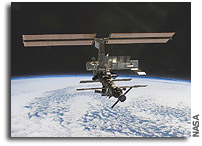ISS Science Operations Status Report Status Report for week ending Nov. 7, 2002
 A trio of European physical science experiments were conducted in the
A trio of European physical science experiments were conducted in the
Microgravity Science Glovebox aboard the International Space Station during
the past week.
European Space Agency Flight Engineer Frank DeWinne from Belgium, a member
of the visiting Soyuz spacecraft crew, on Friday successfully installed and
activated the Protein Crystal Growth Monitoring by Digital Holographic
Microscope (PromISS) experiment, followed on Saturday by the Diffusion
Coefficients in Crude Oil (DCCO). Space Station Science Officer Peggy
Whitson assisted DeWinne during the Glovebox installation activity.
The goal of DCCO is to mix and observe the changes in several compounds
representative of the crude oil chemical families, including n-dodecane,
tetrahydronaphthalene and isobutylbenzene. The results could yield insights
in petroleum processing.
The PromISS uses a digital holographic microscope to accurately
measure the refractive index changes in the precipitating solution
surrounding proteins in the process of crystallization in capillaries.
Analysis of the structure of protein crystals could provide new information
useful in the fields of pharmaceuticals, biotechnology and agriculture.
On Sunday, Expedition Five Commander Valery Korzun and Whitson conducted the
Pulmonary Function in Flight (PuFF) experiment. The PuFF session includes
five lung function tests for each crewmember. The focus is on measuring
changes in the evenness of gas exchange in the lungs and on detecting
changes in respiratory muscle strength caused by long periods in the absence
of gravity. The results will help in maintaining crew health during long
space missions. This is one of many human life sciences experiments being
conducted on Expedition Five under the auspices of the Life Sciences program
at NASA’s Johnson Space Center in Houston, Texas.
DCCO was successfully concluded on Tuesday and it was replaced in the
Glovebox by the Study of Aggregation Mechanism and Kinetics of Nanoslabs
(NANOSLAB) experiment.
NANOSLAB is designed to study the effects of convection and sedimentation
during bulk formation of Silicalite-1 and Silicalite-1 containing aluminum –
zeolite materials important in several industrial applications. Zeolites
are found in many manufacturing processes on Earth because of their ability
to absorb and hold on to materials until they are heated or put under
reduced pressure.
On Wednesday, selected members of the crew filled out the weekly Crew
Interactions computer survey on a laptop computer. The study identifies
important interpersonal and cultural factors that could affect performance
during long space missions.
On Thursday, the crew will set up, operate and deactivate the final European
experiment – Combustion Synthesis under Microgravity Conditions (COSMIC) –
in the Glovebox. The goal of COSMIC is to investigate combustion processes
and the resulting structures in compressed metal powders. This research has
significant relevance to the synthesis of advanced materials such as
intermetallics, ceramics and metal-matrix composites.
The NANOSLAB and PromISS experiments also will be deactivated Thursday and
removed for return to Earth.
The crew also is scheduled to collect background radiation dosimeter badge
readings on the EVA Radiation Monitoring (EVARM) experiment in preparation
for spacewalks during the STS-113 Shuttle mission set for launch on Nov. 11.
EVARM is the first radiation experiment to measure radiation dosages
encountered by the eyes, internal organs and skin during specific spacewalks
and relate it to the type of activity, location and other factors. Analysis
of this information may help reduce potential exposure to spacewalkers in
the future.
Crew Earth Observation photography subjects for this week included Miami,
Fla., Las Vegas, Nev., Phoenix and Tucson, Ariz., Midway Islands, Pearl and
Hermes Reefs and Lisianski Reef in the Pacific, the Nile River Delta,
Angiers, Algeria, Angolan biomass burning, and industrialized Southeast
Africa.
During the past week, the crew continued to perform daily maintenance and
status checks on Station experiments. They also prepared the Station lab
for the arrival of a Soyuz taxi ship this week and approximately eight days
of European science experiments to be conducted in the Microgravity Science
Glovebox.









